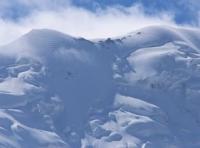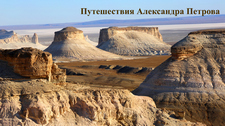Вы здесь
Nalivkin Glacier in Kakshaal-Too Range.

Aitali River is a right tributary of Uzengi-Kush River.
"Directly to the south, from a huge gorge divided into three parts by two longitudinal narrow spurs, a wide, dazzling white glacier slides into the valley. In the overall panorama, it occupies a remarkable place for its beauty. The mighty fields extend far toward the ridge. A sea of ice and firn. A little to the west, from another gorge, the white tongue of yet another glacier glimmers."
Palgov, N.N., "Along Central Tien-Shan." 1929.
Kotur, Aitali, and Sarychat Rivers belong to Uzengi-Kush basin.
Nalivkina Valley Glacier (Aitali) No. 248 is located within Kyzyl-Asker mountain range, on northern slope of western Kakshaal-Too Range in tupper reaches of Aitali River in Atbashi District of Naryn Region.
The upper boundary of the Nalivkina Glacier is located at elevations of 5,555 (Korsun Peak), 5,471 (Letavet Peak), 5,129 (Golodny Peak), 5,089 (Druzhby Peak), and 5,050 (Trapeziya Peak) meters above sea level. The glacier tongue is located at an altitude of 3,875 meters above sea level.
To the south, the upper reaches of the glacier border the 7.7-kilometer-long Fersman Glacier, located on the southern slope of the Kakshaal-Too Range in the Republic of China. Nalivkin Glacier No. 248 is 13.2 kilometers long, covers an area of 18.81 square kilometers, has a perimeter of 30.57 kilometers, and reaches a maximum width of 4 kilometers at its summit.
In the southern part of the spur, which extends latitudinally between the Mushketov and Nalivkin Glaciers, are three glaciers belonging to the Aitali River basin. The southernmost of these glaciers is 2.5 kilometers long, the middle glacier is 3.4 kilometers long, and the northernmost, a small glacier, is 1.5 kilometers long.
Nalivkin Glacier is the second glacier after Mushketov Glacier to feed the Aitali River. The 8.8-kilometer-long Aitali River, which merges with the Sarychat River, is a left tributary of the Uzengi-Kush River.
Nalivkin Glacier was studied by glaciologist N.N. Palgov in 1929.
"The D.V. Nalivkin Glacier was about 2 km from our camp. We approached it along the left lateral moraine, and then climbed through the outwash directly to the end. In total, we climbed about four kilometers up the tsung. The D.V. Nalivkin Glacier stretches for 11.5 km. Its average width is about 1000 m. Its area is 12.75 square kilometers.
The end is located at an altitude of 3675 m, and the foot of the frontal moraine is at 3550 m. Judging by military topographic surveys, the glacier has a branched three-chambered cirque. I personally did not see its upper reaches, as they were lost in the thick fog that had been clouding the atmosphere for two days.
From my upper observation point on the glacier (the moraine cone on the left side), I could barely make out through my binoculars a portion of the firn field 6 - 7 km away. This part of the field appeared flat, with faint slopes on the sides. In the upper reaches, several small mountains flow into the main glacier from adjacent slopes.
On the right side, I counted three of them (in addition, in the lower reaches, there is another steep snowfield, resembling an icefall), two of which fall steeply, and the uppermost one gently. Behind this upper glacier, a massive mountain, completely covered in snow, looms.
A huge mass of snow slides down from it, bulging with drifts and canopies. On the left side, facing east, I saw only one snowfield and one small glacier. The slopes of the mountains accompanying the upper reaches of the main glacier are not particularly steep.
They are almost the same as those on the D. I. Mushketov Glacier, only the ridge lines are somewhat sharper. The snow covering them contributes to the glacier's nutrition, reaching its surface. But in the middle reaches, the snow cover disappears.
Small layers of it appear white only on rock ledges and in hollows. The slopes here become very steep and rocky. But slightly downstream, their left side becomes covered with placers. This region of the mountains produces the predominant mass of moraine material.
The glacier's ridge begins with a wavy relief, in places turning into hummocks. The middle of the glacier along the course is slightly concave, and the edges are raised, with ice hummocks near the banks. Slightly higher. The slope of the current here is 3 - 4°.
The glacier field is furrowed by narrow marginal and transverse cracks, in most cases so closed that only crevices remain. The uniformly hummocky topography of the glacier is broken on its left edge by a highly elevated (15 - 20 m) ridge of ice cones, densely strewn with fine moraine rubble.
To the left of them, directly adjacent to the placers of the lateral mountains, part of the field rises in sharp ridges. The transverse profile of the glacier opposite the aforementioned cones is quite unique. Initially, from the foot of the cones, it descends in the form of a narrow trough, then forms a heave that falls very gently on the opposite side and maintains this gentle slope for a significant portion of the glacier's width, and finally ends in a new heave, equal in height to the first. Closer to the downstream end, the transverse profile changes.
Along the longitudinal axis of the glacier, a typical heave occurs, due to the greatest speed of movement; the edges of the glacier, however, continue to bear lateral heaves, higher than the central heave. The glacier, unlike its preceding neighbors, is abundant with surface streams, some of which flow deep into cracks and pits.
Ice cups are numerous, giving the surface a honeycomb-like appearance. Rock debris and rubble are also encountered. Between them are streaks and patches of dust, concentrated into small, wet grains. Downstream, the glacier surface becomes more furrowed.
The hummocks are more frequent and higher. These are true seracs, rising 5 - 10 meters, and even 15 meters closer to the end of the glacier. Their longitudinal axes are aligned with the glacier's direction, but sometimes they are perpendicular to it, i.e., located across the glacier.
The sun played a primary role in the formation of these seracs. Uneven heating caused local depressions, which were then separated by water flowing from the higher parts of the glacier. The continuous action of the sun and streams broke the glacier field into a hilly surface.
The further downstream, the more intense the combined effect of these factors became. In turn, the ruggedness of the relief became more pronounced: gentle hills turned into hummocks, and the latter into seracs with sharp, peak-like peaks. The direction of the seracs' longitudinal axes depended on the direction of the streams.
Where their waters flowed in line with the glacier's movement, the seracs stretched in the same direction; where streams eroded across or obliquely (which occurred less frequently and is also observed today), the seracs acquired a form with a noticeable elongation in a similar direction.
Their formation pattern is particularly pronounced in the area of greatest development. There, they form characteristic chains of ridges separated by deep ravines. The largest of these ravines runs along the middle of the glacier and is 10 - 12 meters deep and the same width at the bottom.
The ravine beds are strewn with rocks and rubble, glacial slabs (some with columns a meter or more high), and mud accumulations. Streams of varying strength flow along their thalweg. In the ridges between the ravines, seracs are arranged in a variety of combinations: sometimes they form a group, elevated at the edges of the glacier, while other rows form a ring, creating basins with slopes of 8°.
The serac surface, both on the slopes and on the summits, consists of hard, heavily melted snow. However, with rare exceptions, it is free of any moraine deposits, making walking difficult even at moderate slopes. In the upper part of the lower reaches, transverse crevasses occur between the rows of seracs.
These are mostly filled with dense snow, compressed by lateral pressure. The remaining crevasses are shallow and narrow: they can easily be jumped over. The glacier's dip angle in the serac area is difficult to determine directly, but by sighting their surface from the summit of one group to the summit of another, I determined 6°.
At the end of the tsung, the seracs acquire steeper slopes. The ravines between them become wider and deeper, the streams more powerful, and the water in them becomes muddy. The glacier's tongue consists of a complex of ice ridges, crests, and small cones, all densely encased in moraine material or dark streaks of mud.
The glacier's lateral moraines are weakly developed. They lie directly on its edges, rising several meters in the form of hummocks, cones, and more or less elongated ridges. In some places near these lateral moraines, the glacier breaks into blocks of white, bubbly ice, jutting out into tall columns and peaks.
Towards the end, the lateral moraines become more massive. A long, spectacular waterfall falls in a thin stream from a nearby cliff onto the right moraines. Breaking over the ledges, it creates beautiful, smoky cascades. In front of the frontal moraine, a roughly kilometer-long outwash extends from the tip of the tongue.
It is bordered on the sides by lateral moraines, while in the center it is carved into shallow channels through which streams flow. The main body of water, concentrated in these channels, is supplied by the left side of the glacier. Here, one stream flows from a grotto with a man-sized opening and a depressed roof.
Formed by internal melting of the glacier, it appears almost uniform in volume throughout the day. A few meters upstream from the first grotto is another grotto with a collapsed roof. From this flows a second stream, easily waded during calm periods, but during intense ice melt, it becomes so turbulent and wide that the mass of water, bulging out of the grotto under intense pressure, rises up into a mound and bubbles, like a geyser about to erupt.
All the streams that have spread across the outwash reach the frontal moraine and merge into a single channel, which then carves its way into a narrow and fairly deep canyon. The frontal moraine extends for 1.5 - 2 km. Its crests rise 20 - 30 m above the surface of the outwash.
In places, the slopes of the moraine appear damp, saturated with water. It is possible that ice still remains beneath the upper deposits, slowly melting. In the area of the glacial tongue, on the cliffs located to the left, there are traces of a higher ice stand: smoothed slopes and boulders on the summits.
This vanished glaciation likely corresponded to the period of ancient coastal moraines, which remain on the right side of the glacier. The D.V. Nalivkin Glacier is apparently retreating. This is indicated by: the heavily melted end of the tongue and its extremely rugged topography, the absence of any elevated moraine deposits immediately before the end, and the noticeable retreat of the same end from the lateral moraines."
Geographical coordinates of Nalivkin Glacier No. 248: N41°03'10 E77°27'45
What is word "sandr" that N.N. Palgov mentions in his works?
Sandr (from German Sander, pl. Sanderflächen) is a glacial-fluvial plain formed by deposits of meltwater flowing from beneath a glacier. Simply put, it is a plain of sand and gravel deposits that accumulate at the foot of glaciers, where meltwater flows slow down and deposit material washed out of the moraine.
Characteristic features of outwash plains:
- surface slopes slightly outward from the glacier;
- covered with sand, gravel, and sometimes clay, the material being well rounded and sorted by water;
- often containing a network of small branches, oxbow lakes, ravines, and temporary stream beds;
- during glacier retreat, such plains become the site of lakes and swamps, and eventually become covered with vegetation.
Palgov and other Central Asian geomorphologists used the term "outwash plain," for example, to describe:
- "an outwash plain extending north of the tongues of the Nalivkin and Mushketov glaciers," that is, a plain composed of river meltwater deposits where active runoff and sediment accumulation occurred.
An outwash plain is a unique "glacial delta" created by meltwater flows at the outlet of a glacier.
Authority and photos by:
Alexander Petrov.







